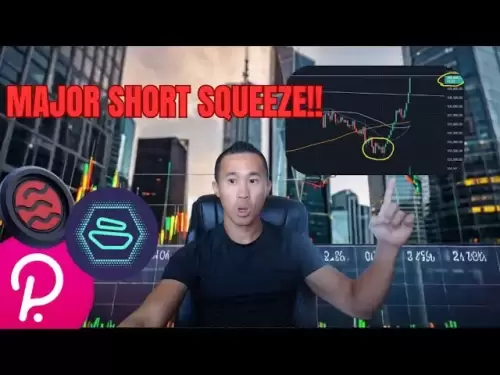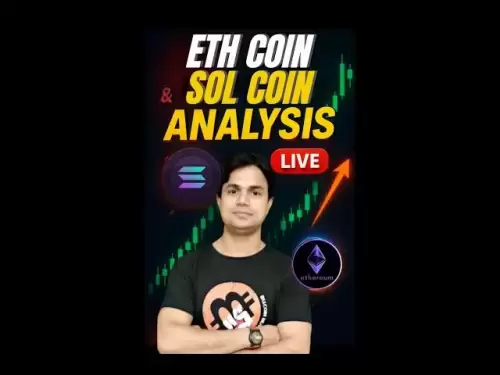-
 Bitcoin
Bitcoin $108,270.9768
2.07% -
 Ethereum
Ethereum $2,489.8066
2.50% -
 Tether USDt
Tether USDt $1.0004
0.01% -
 XRP
XRP $2.2035
0.66% -
 BNB
BNB $661.6608
2.32% -
 Solana
Solana $150.6425
2.13% -
 USDC
USDC $0.9999
-0.01% -
 TRON
TRON $0.2810
0.90% -
 Dogecoin
Dogecoin $0.1645
3.05% -
 Cardano
Cardano $0.5743
4.91% -
 Hyperliquid
Hyperliquid $38.8419
-0.15% -
 Bitcoin Cash
Bitcoin Cash $504.3134
-2.64% -
 Sui
Sui $2.8096
4.35% -
 Chainlink
Chainlink $13.3095
2.21% -
 UNUS SED LEO
UNUS SED LEO $8.9469
0.33% -
 Avalanche
Avalanche $17.9231
3.93% -
 Stellar
Stellar $0.2340
0.74% -
 Toncoin
Toncoin $2.8458
3.21% -
 Shiba Inu
Shiba Inu $0.0...01158
3.47% -
 Litecoin
Litecoin $86.0738
1.94% -
 Hedera
Hedera $0.1507
2.99% -
 Monero
Monero $319.8544
2.31% -
 Polkadot
Polkadot $3.4081
1.95% -
 Dai
Dai $1.0000
0.01% -
 Bitget Token
Bitget Token $4.5645
0.91% -
 Ethena USDe
Ethena USDe $1.0002
0.00% -
 Uniswap
Uniswap $7.2959
5.27% -
 Aave
Aave $272.4623
2.90% -
 Pepe
Pepe $0.0...09680
2.96% -
 Pi
Pi $0.4955
0.78%
How to open high-multiple contracts with BitFlyer
By following these steps, traders can unlock the potential of high-multiple contracts on BitFlyer, leveraging borrowed capital to amplify their gains while assuming increased risk.
Nov 20, 2024 at 01:35 am

How to Open High-Multiple Contracts with BitFlyer
Introduction
High-multiple contracts, also known as leveraged contracts, allow traders to amplify their potential profits by borrowing capital from a derivatives exchange. BitFlyer, a leading Japanese cryptocurrency exchange, offers a range of high-multiple contracts, providing traders with the opportunity to access leveraged exposure to various digital assets. This comprehensive guide will provide a step-by-step walkthrough of how to open high-multiple contracts on BitFlyer.
Step 1: Create a BitFlyer Account
- Navigate to the BitFlyer website and click on the "Sign Up" button.
- Enter your email address, create a password, and agree to the terms of service.
- Verify your email address by clicking on the link sent to your inbox.
- Complete the identity verification process by providing personal information and uploading a photo of your passport or driver's license.
Step 2: Deposit Funds into your Account
- Log into your BitFlyer account and click on the "Deposit" tab.
- Select your preferred deposit method, such as bank transfer or cryptocurrency deposit.
- Follow the instructions provided to complete the deposit.
Step 3: Activate the High-Multiple Contract feature
- Once you have deposited funds into your account, click on the "Contracts" tab.
- Select the "High-Multiple Contract" option from the left-hand menu.
- Check the box to activate the High-Multiple Contract feature.
Step 4: Select the Contract you Wish to Trade
- BitFlyer offers high-multiple contracts on various cryptocurrencies, such as Bitcoin, Ethereum, and Ripple.
- Choose the contract that corresponds to the asset you wish to trade.
- Review the contract specifications, including the underlying asset, leverage ratio, and contract size.
Step 5: Set the Parameters for your Trade
- Determine the entry price for your trade by analyzing the market conditions.
- Select the contract size, which represents the amount of the underlying asset you are trading.
- Choose the leverage ratio, which amplifies your potential profits but also increases your risk.
- Set the stop-loss and take-profit orders to manage your risk and lock in profits.
Step 6: Open the High-Multiple Contract
- Once you have set the parameters for your trade, click on the "Buy" or "Sell" button.
- Review the order details and confirm your trade.
- BitFlyer will execute your trade at the specified price.
Step 7: Monitor and Manage your Contract
- After your trade is executed, monitor its performance in real-time.
- Adjust stop-loss and take-profit orders as needed to manage your risk and secure profits.
- Close the contract when you meet your target or decide to exit the trade.
Additional Tips
- Use a demo account to practice high-multiple contract trading before committing real capital.
- Thoroughly understand the risks associated with high-multiple trading, which can lead to significant losses if not managed properly.
- Consider using a trading bot to automate your trading strategies and reduce manual intervention.
- Keep abreast of market news and technical analysis to enhance your trading decisions.
Disclaimer:info@kdj.com
The information provided is not trading advice. kdj.com does not assume any responsibility for any investments made based on the information provided in this article. Cryptocurrencies are highly volatile and it is highly recommended that you invest with caution after thorough research!
If you believe that the content used on this website infringes your copyright, please contact us immediately (info@kdj.com) and we will delete it promptly.
- XRP Price Targets $2.40 After Descending Channel Breakout: Is $40 Next?
- 2025-07-03 08:50:12
- All Blacks' Loose Forward Conundrum: New Faces and Familiar Battles
- 2025-07-03 08:30:12
- Bitcoin's Wild Ride: Open Interest, Institutional Bets, and Billions on the Line
- 2025-07-03 08:30:12
- Bitcoin, Strategy, & Profit: MSTR's Crypto Playbook and Trump's Digital Diversification
- 2025-07-03 08:50:12
- INJ Price Bull Rally: Smashing Long-Term Resistance – Can It Last?
- 2025-07-03 09:10:12
- Robinhood, OpenAI, and Wallet History: A Tokenized Tale of Intrigue
- 2025-07-03 09:10:12
Related knowledge

How to identify the contract value range in combination with the market profile?
Jul 02,2025 at 10:56pm
Understanding the Market ProfileTo effectively identify the contract value range in combination with the market profile, it's essential to first understand what each concept entails. The market profile is a framework that helps traders visualize how price and time interact across a given period, typically a trading day or session. It provides insights i...

How to use the price slope to filter the false breakthrough signal of the contract?
Jun 20,2025 at 06:56pm
Understanding the Concept of Price Slope in Contract TradingIn contract trading, especially within cryptocurrency derivatives markets, price slope refers to the rate at which the price changes over a specific time period. It helps traders assess the strength and sustainability of a trend. A steep slope may indicate strong momentum, while a shallow slope...

How to determine the expected volatility of the contract through the volatility cone?
Jun 19,2025 at 12:28pm
Understanding the Basics of Volatility in Cryptocurrency ContractsIn the realm of cryptocurrency trading, volatility is a key metric that traders use to assess potential risk and reward. When dealing with futures contracts, understanding how volatile an asset might become over time is crucial for position sizing, risk management, and strategy developmen...

How to formulate a contract intraday trading plan in combination with the pivot point system?
Jun 21,2025 at 03:42pm
Understanding the Basics of Pivot Points in Cryptocurrency TradingPivot points are technical analysis tools used by traders to identify potential support and resistance levels. These levels are calculated using the previous day's high, low, and closing prices. In the context of cryptocurrency trading, where markets operate 24/7, pivot points help trader...

How to adjust the contract position ratio through the price fluctuation entropy?
Jun 22,2025 at 11:42am
Understanding Price Fluctuation Entropy in Cryptocurrency ContractsIn the world of cryptocurrency futures trading, price fluctuation entropy is a relatively new concept used to measure market volatility and uncertainty. It derives from information theory, where entropy refers to the degree of randomness or unpredictability in a system. In crypto contrac...

How to use the volume swing indicator to predict the contract volume-price divergence?
Jun 18,2025 at 11:42pm
Understanding the Volume Swing IndicatorThe volume swing indicator is a technical analysis tool used primarily in cryptocurrency trading to evaluate changes in volume over time. Unlike price-based indicators, this metric focuses solely on trading volume, which can provide early signals about potential market reversals or continuations. The key idea behi...

How to identify the contract value range in combination with the market profile?
Jul 02,2025 at 10:56pm
Understanding the Market ProfileTo effectively identify the contract value range in combination with the market profile, it's essential to first understand what each concept entails. The market profile is a framework that helps traders visualize how price and time interact across a given period, typically a trading day or session. It provides insights i...

How to use the price slope to filter the false breakthrough signal of the contract?
Jun 20,2025 at 06:56pm
Understanding the Concept of Price Slope in Contract TradingIn contract trading, especially within cryptocurrency derivatives markets, price slope refers to the rate at which the price changes over a specific time period. It helps traders assess the strength and sustainability of a trend. A steep slope may indicate strong momentum, while a shallow slope...

How to determine the expected volatility of the contract through the volatility cone?
Jun 19,2025 at 12:28pm
Understanding the Basics of Volatility in Cryptocurrency ContractsIn the realm of cryptocurrency trading, volatility is a key metric that traders use to assess potential risk and reward. When dealing with futures contracts, understanding how volatile an asset might become over time is crucial for position sizing, risk management, and strategy developmen...

How to formulate a contract intraday trading plan in combination with the pivot point system?
Jun 21,2025 at 03:42pm
Understanding the Basics of Pivot Points in Cryptocurrency TradingPivot points are technical analysis tools used by traders to identify potential support and resistance levels. These levels are calculated using the previous day's high, low, and closing prices. In the context of cryptocurrency trading, where markets operate 24/7, pivot points help trader...

How to adjust the contract position ratio through the price fluctuation entropy?
Jun 22,2025 at 11:42am
Understanding Price Fluctuation Entropy in Cryptocurrency ContractsIn the world of cryptocurrency futures trading, price fluctuation entropy is a relatively new concept used to measure market volatility and uncertainty. It derives from information theory, where entropy refers to the degree of randomness or unpredictability in a system. In crypto contrac...

How to use the volume swing indicator to predict the contract volume-price divergence?
Jun 18,2025 at 11:42pm
Understanding the Volume Swing IndicatorThe volume swing indicator is a technical analysis tool used primarily in cryptocurrency trading to evaluate changes in volume over time. Unlike price-based indicators, this metric focuses solely on trading volume, which can provide early signals about potential market reversals or continuations. The key idea behi...
See all articles

























































































